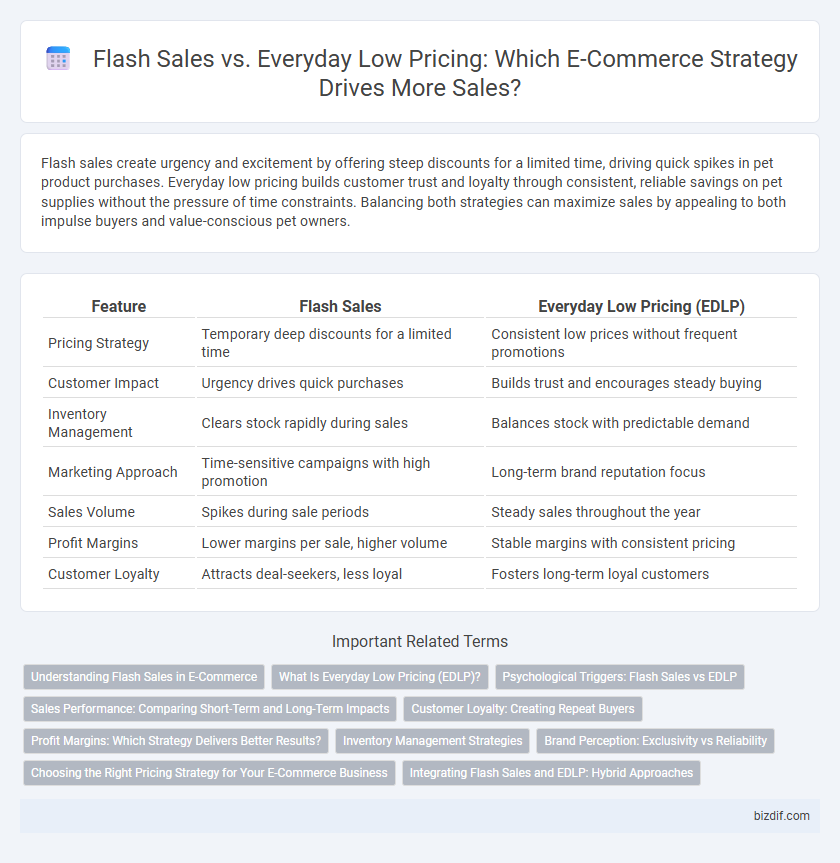Flash sales create urgency and excitement by offering steep discounts for a limited time, driving quick spikes in pet product purchases. Everyday low pricing builds customer trust and loyalty through consistent, reliable savings on pet supplies without the pressure of time constraints. Balancing both strategies can maximize sales by appealing to both impulse buyers and value-conscious pet owners.
Table of Comparison
| Feature | Flash Sales | Everyday Low Pricing (EDLP) |
|---|---|---|
| Pricing Strategy | Temporary deep discounts for a limited time | Consistent low prices without frequent promotions |
| Customer Impact | Urgency drives quick purchases | Builds trust and encourages steady buying |
| Inventory Management | Clears stock rapidly during sales | Balances stock with predictable demand |
| Marketing Approach | Time-sensitive campaigns with high promotion | Long-term brand reputation focus |
| Sales Volume | Spikes during sale periods | Steady sales throughout the year |
| Profit Margins | Lower margins per sale, higher volume | Stable margins with consistent pricing |
| Customer Loyalty | Attracts deal-seekers, less loyal | Fosters long-term loyal customers |
Understanding Flash Sales in E-Commerce
Flash sales in e-commerce create urgency by offering limited-time discounts on select products, driving a sudden surge in traffic and sales volume. These time-sensitive promotions leverage scarcity and excitement to attract deal-seeking shoppers, often boosting customer acquisition and inventory turnover. Flash sales require precise inventory management and marketing strategies to maximize profitability without eroding brand value.
What Is Everyday Low Pricing (EDLP)?
Everyday Low Pricing (EDLP) is a retail strategy where e-commerce platforms maintain consistently low prices on products without frequent discounts or flash sales. This approach builds customer trust by offering stable and predictable pricing, reducing the need for comparison shopping. EDLP helps increase customer loyalty and simplifies pricing management, enhancing the overall shopping experience.
Psychological Triggers: Flash Sales vs EDLP
Flash sales leverage scarcity and urgency, triggering impulse buying by creating a limited-time offer that activates fear of missing out (FOMO), which heightens consumer excitement and drives immediate purchases. Everyday Low Pricing (EDLP) appeals to consumers' desire for consistency and trust, reducing the cognitive load by eliminating the need to wait for discounts and fostering a perception of reliability and value. Both strategies tap into different psychological triggers: flash sales stimulate excitement and urgency, while EDLP builds long-term confidence and loyalty through predictable pricing.
Sales Performance: Comparing Short-Term and Long-Term Impacts
Flash sales drive rapid spikes in sales volume and create a sense of urgency that boosts short-term revenue and customer acquisition. Everyday low pricing (EDLP) strategies foster consistent sales growth and build long-term customer loyalty by offering stable, competitive prices without the need for constant promotions. Data indicates that while flash sales generate immediate transaction surges, EDLP supports sustained profitability and reduces operational costs linked to frequent discounting.
Customer Loyalty: Creating Repeat Buyers
Flash sales generate urgency by offering steep discounts for limited periods, which can temporarily boost customer acquisition but may attract deal-seekers with low brand loyalty. Everyday low pricing (EDLP) fosters consistent value perception, encouraging repeat purchases and stronger customer retention through predictable savings and trust. Brands leveraging EDLP strategies typically achieve higher lifetime customer value by cultivating reliable shopping habits and reducing price-based churn.
Profit Margins: Which Strategy Delivers Better Results?
Flash sales generate higher short-term profit margins by creating urgency and driving quick bursts of high-volume sales, often attracting bargain hunters willing to purchase impulsively. Everyday low pricing (EDLP) maintains steadier profit margins over time by building customer trust and encouraging consistent purchasing behavior without the need for frequent discounts. Brands aiming for long-term profitability benefit from EDLP, while those seeking rapid inventory turnover and spike revenue might prefer flash sales for maximizing immediate margins.
Inventory Management Strategies
Flash sales create rapid inventory turnover by offering limited-time discounts, encouraging quick customer purchases and reducing holding costs, but require precise demand forecasting to avoid stockouts or overstock. Everyday low pricing (EDLP) stabilizes inventory flow by maintaining consistent price points, simplifying replenishment schedules and minimizing the risk of inventory obsolescence. Effective inventory management leverages real-time sales data analytics to balance stock levels, ensuring that flash sales capitalize on demand surges while EDLP supports steady inventory movement.
Brand Perception: Exclusivity vs Reliability
Flash sales create a sense of exclusivity and urgency that can elevate brand perception by offering limited-time, high-value deals, attracting bargain hunters and impulse buyers. Everyday low pricing fosters a reputation for reliability and trustworthiness, signaling consistent value and transparent pricing that appeals to loyal customers seeking long-term savings. Balancing exclusivity with reliability influences consumer trust and engagement, shaping overall brand loyalty and market positioning.
Choosing the Right Pricing Strategy for Your E-Commerce Business
Flash sales create urgency and drive short-term spikes in traffic and conversions by offering deep discounts for limited periods, ideal for clearing inventory quickly. Everyday Low Pricing (EDLP) builds consistent trust and loyalty by providing stable, competitive prices that encourage repeat purchases and long-term customer retention. Selecting the right pricing strategy depends on your e-commerce business model, product lifecycle, and customer behavior analytics to balance profitability and market positioning effectively.
Integrating Flash Sales and EDLP: Hybrid Approaches
Integrating flash sales with everyday low pricing (EDLP) creates a hybrid strategy that boosts customer engagement while maintaining consistent value perception. Flash sales generate urgency and drive short-term spikes in traffic, whereas EDLP fosters long-term loyalty through predictable pricing. This balanced approach leverages the benefits of both techniques, optimizing revenue and enhancing competitive positioning in e-commerce markets.
Flash Sales vs Everyday Low Pricing Infographic

 bizdif.com
bizdif.com